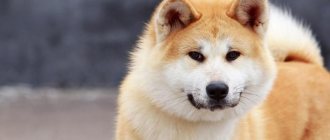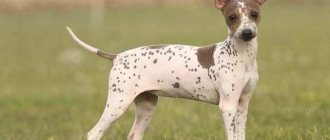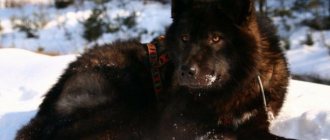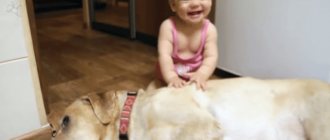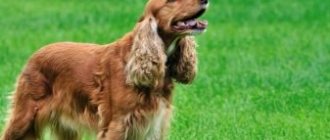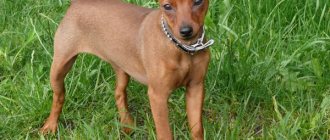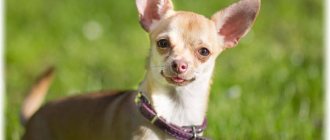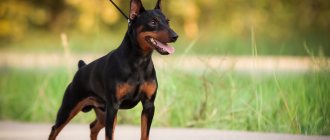The American Akita (akita american) is a young dog breed that is rapidly gaining popularity around the world. Their colorful appearance and strength, which is noticeable to the naked eye in these dogs, make them desirable pets for many dog breeders. However, it should be understood that a harmonious appearance does not guarantee a soft and flexible character.
History of the origin of the dog
The ancestors of this breed are Japanese Akita Inu, dogs that were originally used for hunting and guarding. In the 19th-20th centuries, when dog fighting became fashionable, the owners of Akita Inu, or, as they were called before, Matagi Akita, began to use their pets for fights. The desire to make the Akita Inu larger and stronger to win in battles led to the crossing of these dogs with mastiffs and shepherd dogs and their gradual loss of classic breed traits.
This was discovered in 1914 at an exhibition held in Tokyo. After this, purebred representatives of the breed were declared natural monuments, interbreed matings were prohibited, and breeders began work to return the Matagi Akita to its original characteristics.
Due to a government decree, during World War II, breeders were required to donate dogs for the needs of the front. When the war ended, American soldiers returned home and took several puppies with them. It was they who, a few years later, laid the foundation for the emergence of a new breed, the representatives of which were initially called “large Japanese dogs.”
Breeders from the USA and Japan carried out work on the development of breeds in parallel, without coordinating them with each other. This was the reason for the emergence of serious differences in the character and appearance of American and Japanese Akitas.
The breeds were officially separated in 2000 when the FCI approved the American Dog Standard.
Akita officialdom: no limits
At the end of 2010, in the AKIHO rings, the panel of judges and the invited expert community canceled the dimensional parameters of the Akita Inu declared by the standard. The collective opinion of Akita authorities was unanimous: dry boundaries fetter the ancient shaggy aristocrats and are detrimental to the development of the breed. A “no limits” proposal was put forward: when evaluating a dog on the exhibition track, one should use the terms “massiveness measure”, “volume balance”, “harmony of appearance”.
The new Japanese standard fundamentally excludes the growth parameter: a tall (at the withers) dog and a squat (stocky) animal can (and should) be ideal. The standard “weight distribution”, accordingly, has also sunk into oblivion: the basic register operates with recommended parameters-numbers. Approximate weight /height of an adult Akita Inu dog:
- a male Akita Inu with a height of 64-70 cm can have a weight in the “fork” of 30-40 kg;
- An Akita Inu female with a height at the withers of 58-64 cm usually weighs 20-30 kg.
The Japanese canine community insists: an adult Akita Inu should look dry, fit, elegant, swiftly predatory and very powerful. No “meat gain” (excessive muscles) or fat deposits. Fat layers “smear” the silhouette, “ground” the image, and negatively affect the condition of the coat and vitality.
New reference trends created a sensation in the Akita community and provoked pet food manufacturers to reconsider the contents and calorie content of the already complex Akita Inu diet.
The traditional island menu was based on sea fish, rice and seaweed; modernity has demanded that Akita Inu “crackers” be low in fat and have a fixed level of protein. Variations of winter/summer feed have also entered the market: the summer diet is light, in contrast to the heavy protein-fat winter menu.
Differences from Japanese
Japanese Akita Inu.
The main differences between American Akitas:
- the standard allows any coat color and the presence of a mask on the face;
- representatives of this breed are larger than Japanese Akitas;
- they have a softer undercoat and hard outer hairs.
Also, “Americans” are distinguished by pronounced leadership qualities and a tendency to fight.
Pros and cons of the breed
On the Internet you can find reviews about this breed, both negative and positive. Some users claim that Akitas are uncontrollable, while others dote on these animals, considering them their best friend.
Advantages of the breed:
- adequate and mentally stable;
- faithful and devoted;
- with good qualities as a hunter;
- excellent defenders;
- love children;
- clean animals.
Minuses:
- heavy, twice a year, shedding;
- aggressive towards other people's dogs, do not like their own, but tolerate them;
- a very independent breed.
Some consider it a disadvantage that you need to take your dog for an active walk for 1-2 hours every day.
Description of breed characteristics
American Akitas are strong, large, harmoniously built dogs with a powerful body and massive bones. Their confidence and power can be felt even in their gait: representatives of this breed have strong, free movements with a moderate lunge and push.
Types by coat type
Representatives of this breed can be:
- long-haired - such dogs have a plentiful head and tail covered with hair, and the elongated fur on the paws forms “pants”;
- short-haired - these individuals have a double coat, consisting of coarse, straight guard hairs and a shorter, soft and dense undercoat.
It is believed that the long-haired representatives of the breed were obtained accidentally as a result of a genetic failure.
Longhaired Akita Inu.
Appearance
In accordance with the breed standard for the American Akita:
- large head, flat and wide skull between the ears with a well-defined but not sharp stop;
- wide, black nose (for individuals with white fur, blurred color or slight depigmentation is acceptable);
- black, non-sagging lips;
- powerful jaws, scissor bite;
- the eyes are small, triangular, the iris is dark brown;
- the ears are small, erect, V-shaped, wide at the base;
- the neck is thick, short, with developed muscles, the scruff is convex;
- the back is straight, the lower back is muscular;
- The chest is wide and deep, the ribs are arched;
- the stomach is moderately tucked;
- the tail is set high, abundantly covered with hair, curved into a ring;
- the limbs are straight, strong and muscular, the paws are “cat-like”.
The coat is double, consisting of straight, coarse guard hair and thick, soft and dense undercoat. Disqualifying defects include depigmentation of the nose, overshot or undershot, semi-erect or hanging ears, straight or crescent-shaped tail, cryptorchidism in males, aggressive behavior, and cowardice.
Males grow to 66-71 cm at the withers and weigh 45-65 kg, females reach a height of 61-66 cm with a body weight of 32-45 kg.
Character
American Akitas have a difficult character. They are independent, willful and freedom-loving, love to control everything and always strive to take a leadership position. At the same time, these are calm and affectionate dogs with a balanced psyche, who rarely bark and always behave with dignity and restraint. Representatives of this breed are infinitely devoted to their owner, yearn in his absence and need constant communication. However, they also require personal space and will never impose themselves if they see that the owner is busy. The main thing for these dogs is to feel care and attention.
“Americans” are fearless, they are born guards and defenders. Therefore, they treat strangers quite warily and with distrust. They need time to get used to people and greet guests in a friendly manner. They have difficulty getting along with other animals. Oddly enough, Akitas are more loyal to cats, while in dogs, especially males, they see exclusively as rivals with whom they need to fight for leadership.
Representatives of this breed are intelligent, but quite difficult to train due to the habit of always acting independently. The owner will need to show patience, persistence and leadership skills to gain the pet's respect and obedience.
Peculiarities
These dogs are excellent hunters. This trait cannot be suppressed in them - it will manifest itself one way or another, and probably not from the best side for the owner. For example, a pet will begin to regard birds, cats, or smaller dogs as prey on walks. From the Japanese Akita Inu, the “Americans” have inherited incredible devotion - they literally depend on their owner and have a hard time bearing his loss. That is why they are often called a one-owner dog.
These dogs have excellent memory and remember how they are treated. Therefore, you should not shout at the puppy, treat him with disdain, and especially punish him physically. The pet will remember this and hold a grudge. In this case, it will be difficult to regain his favor and gain respect again.
Advantages and disadvantages
American Akitas, like other breeds, have their pros and cons. Among the indisputable advantages of these dogs are:
- loyalty and devotion;
- stable psyche;
- hunting and protective instincts;
- ability to get along with children;
- cleanliness;
- courage;
- possibility of street maintenance;
- high life expectancy;
- ease of care;
- intelligence and intelligence;
- rare barking.
Disadvantages of American Akitas:
- stubbornness and love of freedom;
- heavy shedding;
- desire for dominance;
- Possibility of aggressive behavior towards other dogs.
In addition, these dogs need regular long walks and physical activity, which many also regard as a disadvantage of the breed.
Lifespan
Representatives of this breed live on average 10-14 years.
Color
The breed standard for American Akitas allows for any coat color. The most common options with photos:
- white - the coat is solid white, the lips, nose and paw pads are pigmented black, there is no mask or spots;
- Pinto - the main color of the coat is white, there are spots of a different color on it, covering a third of the body and the muzzle, the mask is black or black and white or there is none at all;
- fawn – the coat is light, without yellowness or redness, a black mask may be present;
- brindle - on the main yellow, fawn, brown or gray color of the coat there are transverse dark stripes.
The shade of the undercoat may be slightly darker or lighter than the main coat color.
White.
Pinto.
Brindle.
American Akita: dog character, behavior
The large Japanese dog is very loyal to its owner. She singles out one person from the pack and is ready to follow him to the ends of the earth. As a rule, this person is a strong leader. This can be either a man or a woman. She becomes less attached to other family members. But the worst punishment for her is loneliness. It is absolutely contraindicated for her. Left to its own devices, the pet begins to get mischievous and its character deteriorates. The consequences of loneliness may be irreversible.
The most pronounced character traits of the American Akita:
- focused on communication with the owner,
- selfless devotion to the owner and family,
- patience and calmness in the absence of strong irritants,
- independence that needs to be channeled in the right direction.
Behavior at home
The American Akita dog breed has many feline traits in its character. She will follow her owner's heels, caress her, and won't mind crashing on the couch with him. Unless he won't purr. You will rarely hear your pet's voice. You can't call a pet a windbag. It attracts the owner's attention only when there is a real danger to him or the owner. Unless the loud-voiced relatives living nearby teach him to bark. It must be said that with pets living under one roof, a large Japanese dog can exist peacefully. But for this, the owner needs to show great patience in raising him.
Behavior on the street
This is the dominant breed. The American Akita is a dog that expects obedience from other members of the pack, and especially from strangers. Owners need to be attentive to any manifestations of aggression on its part. This is usually true outside the home. While walking, Americans love to get into fights. Males are more prone to this behavior, but there are also cases of fights between females. This always happens unexpectedly, so it is better to minimize contact between pets and other relatives.
A socialized dog is not aggressive towards strangers, which is confirmed by the characteristics of the breed. But this does not mean that you can allow people you meet to play pranks with him. The pet may perceive such games as an attack, then a conflict is inevitable. Dog handlers do not recommend that strangers look an Akita directly in the eyes, and especially bend over when doing so. The dog perceives this behavior as aggression. Experienced owners assure that the American Akita always distinguishes imaginary danger from real danger. This is a really smart dog, but it all depends on its level of socialization, so it’s not worth the risk.
Attitude towards children
The dog allows children a lot. He can play with them or calmly wait until the owner’s kids calm down and stop trying to pull his ears. But all patience may come to an end. Even such a calm and peaceful dog can harm a child. And although some manage to use her as a nanny, it is still not recommended to leave such a large dog as the American Akita alone with children. The description of the breed suggests that aggression is not typical for it. But in the heat of the game, she can drop the baby, trample on him, thereby seriously injuring him. To do this, she doesn’t even have to make any special efforts; her considerable weight will do everything for her.
Table of weight and height by month
| Age | Height at withers, cm | Weight, kg | ||
| Male | Bitch | Male | Bitch | |
| 2 months | 35-38 | 31-35 | 8-9 | 7-8 |
| 3 months | 38-43 | 35-41 | 13-15 | 11-14 |
| 4 months | 43-51 | 41-48 | 18-21 | 15-18 |
| 5 months | 51-56 | 48-54 | 22-25 | 20-22 |
| 6 months | 56-61 | 54-58 | 27-30 | 24-26 |
| 9 months | 61-63 | 58-61 | 32-36 | 28-32 |
| 1 year | 63-67 | 61-64 | 36-39 | 34-38 |
| 18 months | 67-71 | 64-66 | 40-44 | 38-42 |
The data given in the table is averaged. Minor deviations are not a cause for concern.
Diet
Each Akita owner chooses what the food will be: natural products or dry food.
Premium food contains all the additives and components that are important for a dog’s growth and health. Height, weight and age are taken into account in each dry food category.
Don't buy babies when they are only a month or two old. At this time, their only food is mother's milk.
If the owner decides to feed the pet natural products, then it is necessary to create a diet. Of the total daily ration, meat and offal make up ½ part, vegetables and fruits ¼ part and cereals ¼ part.
From puppyhood, you need to accustom your Akita to a daily routine and feed it on time. Until the puppy grows up, the amount of food is controlled. If the baby does not eat enough, the portion is increased.
Dog handlers advise excluding from the diet: fatty foods, baked goods, sweets, raw fish. Tubular bones should not be given.
Adult dogs are fed twice a day, puppies up to 7-9 months three times a day. Dog handlers do not recommend mixing dry food and natural food.
Feeding
Representatives of this breed can be fed with natural products or industrial dry food. Each type of feeding has pros and cons, so there is no clear answer which one is better. The choice depends on the views and preferences of the dog owner, the main thing is not to mix them.
The number of daily feedings depends on the age of the pet:
- 2 months – 5 times;
- 4-5 months – 4 times;
- 6-8 months – 3 times;
- 9 months and older – 2 times.
With a natural diet, the dog’s diet should include:
- dietary meat (beef, rabbit, turkey) raw or scalded with boiling water;
- cereals (rice, buckwheat);
- boiled sea fish;
- low-fat fermented milk products (yogurt, kefir, cottage cheese);
- eggs (no more than once a week);
- offal (lung, liver, tripe, heart);
- seasonal fruits and vegetables (carrots, zucchini, apples);
- sea kale.
It is prohibited to give your pet:
- fat meat;
- spicy food;
- sweets, pickles, seasonings, smoked foods, marinades;
- garlic, onion;
- bakery and pasta products;
- tubular bones;
- river fish;
- legumes
When eating natural foods, vitamin-mineral complexes (Unitabs Brevers Complex, Beaphar Doggys, Radostin) are additionally included in the diet.
Approximate weekly diet for an adult:
| Day of the week | Menu |
| Monday | 600 g turkey, 400 g rice porridge, 400 ml kefir, 500 g vegetables |
| Tuesday | 800 g beef, 400 ml yogurt, 400 g vegetables, 400 g rice porridge |
| Wednesday | 1 kg of sea fish, 300 g of buckwheat porridge, 400 g of cottage cheese, 500 g of vegetables, 2 tsp. seaweed |
| Thursday | 600-800 g beef, 300-400 g rice porridge, 400 g cottage cheese, 400 g vegetables, 2 tsp. seaweed |
| Friday | 1 kg of sea fish, 300 g of buckwheat porridge, 500 g of cottage cheese, 300 g of vegetables, 2 tsp. seaweed |
| Saturday | 1 kg of sea fish, 300 g of buckwheat porridge, 500 g of cottage cheese, 1 egg, 400 g of vegetables |
| Sunday | 800 g rabbit meat, 400 g buckwheat porridge, 500 g cottage cheese, 400 g vegetables, 2 tsp. seaweed |
If the choice falls on industrial feed, you should not purchase economy class products. These foods do not contain the vitamins and minerals necessary for a dog’s growth and development; they contain a lot of grains and meat waste. Premium or super-premium food is suitable for American Akitas. Products from the brands Hills, Royal Canin, Monge, and Bosch are popular among breeders.
Purpose
The professional orientation of the breed is determined by talents and condition. An excellent sense of smell and keen eyesight, supported by tenacity (gambling combativeness), glorified the breed as excellent hunters. This is the canonical husky, an icon of the style of the taiga fisher, universally working on any game. Tracking, pursuit and fixation of large animals (elk, deer, boar, bear) until the shooter arrives. Search and barking of fur-bearing animals (squirrel, sable, marten), gun work and retrieval of the entire species range of birds. The hunting nature must be understood and taken into account in organizing the everyday life of a pet: gross suppression of temperament has a negative impact on behavioral reactions, manifested in aggression towards neighboring animals, and the destruction of yard animals.
The legendary devotion of the breed is the most important personal parameter realized in the security and guard service. An adult American Akita will not allow a stranger to enter the house and will firmly protect the clan from intruders.
With proper upbringing and thoughtful training, an Akita will master all types of services, any special courses and will adequately demonstrate its abilities in pet sports.
Sports with a dog is not only health improvement, but also an opportunity to establish close contact with your pet. Large Japanese dogs are great for:
- agility: an obstacle course of twenty projectiles;
- weightpulling: athletic pet sport, dragging heavy loads;
- freestyle: sport dancing with a dog. Artistic American Akitas amaze with their plasticity, grace and musicality;
- coursing: hunting for mechanical bait;
- skier towing and sled racing;
- canicross, cross-country running with a dog (from 3 to 5 km).
Socialized, well-trained and busy with work, the American Akita is an ideal dog for living together in country cottages with a large local area. Large, hardworking dogs are an excellent choice for a modern fisher, athlete, dynamic person who loves a fast-paced life.
Choosing a nickname
If the puppy was purchased from a kennel and has the necessary documents confirming its pedigree, it already has a name. Breeders give official nicknames to each puppy in the litter, based on the rules of the club. So, most often the nickname begins with a letter corresponding to the serial number of the litter, reflects a certain theme and contains the name of the father or the name of the club. This nickname is used, for example, at exhibitions.
At home, the puppy can be called any name you like. The main thing is that it matches the dog’s character and reflects its characteristics. Often, owners strive to emphasize the pet’s roots by choosing a Japanese nickname, which not only sounds beautiful, but also carries a certain meaning:
- Aki – born in autumn;
- Yoshiko is a good child;
- Keiko – beloved;
- Kyoka – happy;
- Takara is my treasure;
- Fuku – lucky;
- Akina - spring;
- Yume is a dream;
- Hana – flower;
- Toshi – reflection;
- Chico – swift as an arrow;
- Miki – flower stem;
- Katana is as dangerous as a Japanese sword;
- Sakura – cherry blossom;
- Ichigo is a strawberry.
Also popular are nicknames such as Adam, Bonnie, Willie, Hector, Jerry, Zeke, Kevin, Lyon, Morty, Nikki, Oscar, Patrick, Robbie, Sims, Teddy, Phoebus, Hugo, Charlie, Athena, Bertha, Vicky, Gabi, Dina , Irma, Carla, Lara, Mirta, Nika, Pixie, Runa, Santa, Tora, Frida, Sherry.
How to choose a puppy
You should buy an American Akita puppy from trusted breeders who have been on the market for several years. It would be useful to find all possible information about the seller on the Internet and read reviews. An experienced breeder who values his reputation will definitely tell you which puppy is best for you. Some need a good hunter, others need a potential winner of all possible exhibitions, and others just need a good and faithful friend for themselves and their children, and to protect the house.
Be sure to look at the parents of the future pet. This is very important because the offspring inherits their appearance and behavior. If it turns out that the mother or father is cowardly or, conversely, aggressive, then the puppy you choose may very likely turn out to be the same.
Be sure to pay attention to the appearance of the American Akita puppy. He should have shiny fur that is soft to the touch. While petting such a puppy, an association with a plush toy involuntarily arises. If he is too thin, has a swollen tummy, red and watery eyes, or twisted elbows and knees, then it’s better not to take risks and don’t take it. You should not take a puppy that is too young in age, since professionals do not assign show classes to dogs under 9 months.
Your future pet should be active. Lethargy in behavior is a sign of depression, which in turn may indicate a particular disease. If possible, to rule out hidden illnesses that may manifest themselves in the future, pay attention to the puppy's feces. Its consistency and color may confuse you. In this case, you should refrain from purchasing.
Diseases
American Akitas have good health and good immunity. However, there are a number of diseases characteristic of representatives of this breed:
- allergic reactions;
- volvulus;
- retinal atrophy;
- cataract;
- hip dysplasia;
- seborrheic adenitis;
- hypothyroidism;
- dermatitis;
- Cushing's syndrome;
- pemphigus foliaceus;
- inversion and eversion of the eyelids;
- hyperkalemia;
- epilepsy.
In addition, these dogs often experience intolerance to anesthesia and hormonal imbalance, leading to infertility.
Veterinary
American Akitas are strong, healthy dogs with strong immunity. The animal will live long and happily if a caring owner organizes good nutrition, provides work, and organizes professional life support: registers the pet at a veterinary clinic, joins the medical examination system, and vaccinates the animal.
All breeds have bad heredity and negative genetics: however, if you buy a dog of good blood from a reputable kennel, many diseases and hardships can be avoided: a half-breed, a mixed breed of an American Akita - a guaranteed problem and huge bills from the veterinarian.
There are no exotics in the list of veterinary threats to PJD, only the “pathological standard” of large, massive dogs:
- hip dysplasia;
- dermatitis;
- vision problems;
- allergies to food and household chemicals.
Care and maintenance
These dogs can be kept in an apartment only if it is large enough and has air conditioning so that the pet does not overheat. Also in this case, the dog must be walked at least twice a day for 1-1.5 hours. Thanks to their dense and dense wool, representatives of this breed are not afraid of cold weather, so the most suitable housing option for them is an equipped spacious enclosure with a booth.
These dogs should not be kept on a chain - this negatively affects their character, provoking anger and aggressive behavior.
“Americans” are taught to be muzzled from an early age. It is necessary when completing a course of OCD, and will also help protect your pet and avoid the possibility of poisoning during walks, preventing it from picking up spoiled food from the ground and eating it. Caring for representatives of this breed is easy. It consists of regular hygiene procedures, to which the dog is taught from puppyhood.
Wool and bathing
The coat of American Akitas is not prone to matting and matting, so it is enough to brush it 1-2 times a week with a metal comb. During seasonal shedding (spring and autumn), the coat is combed daily with a furminator or slicker brush - this helps get rid of dead hair and improve the dog’s blood circulation. After each walk, wipe the pet’s paws with a damp towel and inspect them for injuries and cracks.
Representatives of this breed are bathed as needed, approximately once a quarter, using a special shampoo appropriate for their coat type.
Eyes
The eyes are examined regularly and wiped with a soft, lint-free cloth to remove small gray lumps that may appear in the corners of the eyes. In case of increased lacrimation, swelling of the eyelids and excessive acidification, it is necessary to show your pet to a veterinarian.
Ears
The ears should be pink, without excess wax. They are inspected weekly and wiped with a cotton pad soaked in a special lotion or hydrogen peroxide. If there is a large accumulation of earwax, an unpleasant odor or redness, you should contact a specialist to determine the cause of their appearance.
Teeth
To prevent the formation of plaque and tartar, your pet’s teeth should be brushed 3-4 times a week using dog paste and a special brush or finger attachment.
Claws
Nails are trimmed every 3-4 weeks using a guillotine nail clipper for large breeds. Sharp edges are smoothed with a nail file to avoid chips and burrs.
Caring for your pet also involves timely vaccination and deworming.
Training and education
Before you get a cute puppy, you need to know how to raise an American dog. This is a breed that needs to be negotiated with. They say she needs a firm hand, but with a soft glove. The dog will not follow the same commands if he does not see the point in them. You shouldn’t take him to the site for a training course (OCD) if you don’t know what to do there. He won’t understand why he needs to carry out the same commands day after day. The “stick” method also does not work; it is better to use the “carrot”.
The most difficult period for a dog is growing up. Training an American Akita during puberty requires special skills. The puppy has attacks of superiority over people. How you go through this period will determine who will be the boss in your house. You don’t need to raise your voice often at your Akita, and you shouldn’t hit him at this time. But if a grown-up puppy opens its mouth at its owner, you need to grab it by the lower jaw and hold it until the pupil realizes his guilt.
The genes of this breed have a desire to protect the owner. This is the nature of the American Akita. Therefore, special attention should be paid to the “Place” command. Otherwise, the dog will sleep by your bed, wait under the kitchen door and watch all your movements around the house. Important commands are also “Near”, “To me”. If the dog has not yet mastered them, do not let him off the leash on the street.
Choosing a puppy and its cost
It is better to purchase a puppy from a specialized nursery from professional breeders - this minimizes the risk of buying a sick dog or a mixed breed. First you need to inspect the living conditions of the animals, meet the parents of the future pet, learn about their character and health.
In a healthy standard American Akita puppy:
- shiny, soft wool;
- clean eyes and ears, no increased lacrimation;
- cold nose;
- no rashes or redness on the skin;
- scissor bite.
The puppy should be active, cheerful and inquisitive; there should be no signs of aggression or cowardice in his behavior. The cost of an American Akita puppy depends on the class to which it belongs. Thus, the average price of a pet class representative is 10-15 thousand rubles, a breed class representative is 15-30 thousand rubles, a show class representative is from 45 thousand rubles.
Walking and exercise
This is a multifunctional dog that was bred to hunt bear, wild boar, and deer. The couple can hold the bear until the hunter comes. In Japan they were used to drive fish into nets. They can bring the duck to local hunters without damaging the carcass. You can train an American Akita to be a guide dog, or you can teach it to pick mushrooms. In any case, a walk with her will not be boring.
Beginning dog breeders often think that the American dog needs intense exercise during walks. Actually this is not true. Yes, she loves to walk, but prefers to do it slowly. A long distance is not a problem for her, she just wants to overcome it by walking, but not by running. The attitude of different individuals to water differs - some like to swim, others do not come close to the water.
